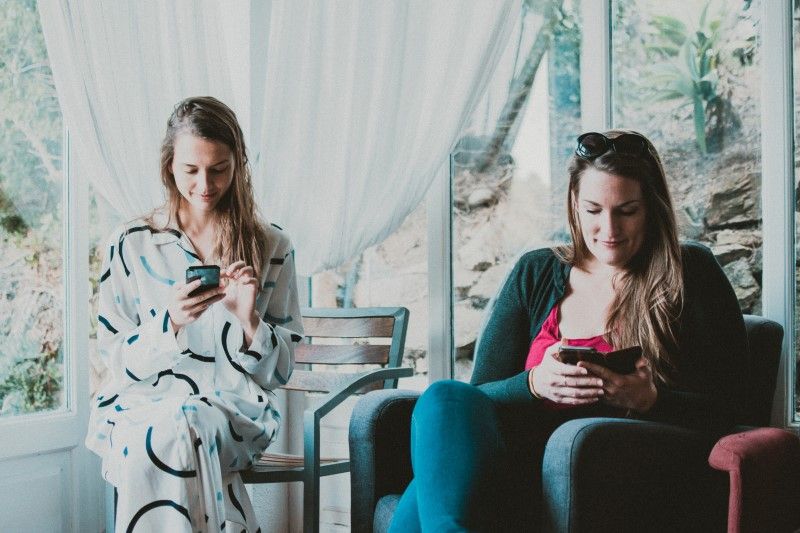This holiday, what if we voluntarily set our screens aside for a few weeks and turn our attention to the season and each other?
What if we gave ourselves—and our families—the gift of our best selves?
Since you’re reading The Art of Simple, I imagine you’ve already thought about what’s really important and considered how much commercialism you’ll accept during the holiday season.
But what’s all the intention for if our family’s screen use crowds out the space to enjoy it?
If your family has lots of interactive screens, the screens are revving up (and stressing out) nervous systems, making it more difficult to regulate emotions, focus, and participate in other things.
Then there’s the addictive qualities of interactive screens. For my son, if there are screens available, he doesn’t know what to do with himself and will spend most of his non-screen time complaining about how he’s not using them.
Once screen use is out of the question? He’s helping with dinner, reading books, cleaning his room without being asked, and practicing the piano.
Besides that, more time with screens is less time with each other. So when everyone takes a break at the same time, we allow space for the smoke to clear and see who we really are, individually and as a family, underneath it all.
There will be resistance the first few days (from within and without). But a few days later you won’t believe the transformation.
With a bit of planning, you can do a family screen fast for the holidays.

How to Do a Family Screen Fast
The key to a successful screen fast isn’t naturally cooperative children. The key is to plan, plan, plan. The more you plan, the easier—and more successful—your screen break will be.
1. Talk to your kids about the screen fast in advance
Help your kids see why a screen fast might be a neat experiment. Find an explanation that sounds right to you and go with it.
For instance, you could tell your kids that scientists are noticing that many problems come from our overuse of screens and that you think Christmas is a good time to focus on other things like spending time together.
Let your kids know it will last through Christmas and then you’ll see how the experiment went. Tell them about the plan two to three days in advance.
2. Tell friends and family what you’re up to
Tell friends and family you’ll only check your messages in the evening and that they’re welcome to call you if they need you at other times. During the screen fast, call people to finalize plans instead of participating in lengthy text threads. Leave voice messages.

3. Plan for when your kids are away
If you have kids, you won’t see much of a change in their mood, focus, attitude, and participation if they’re leaving the house and using screens elsewhere. In fact, they’re likely to be even more frustrated at home because they’ll be primed for dissatisfaction with the situation. With their nervous systems all revved up, they’ll be far less capable of managing their emotional response.
This is because of screen time’s effect on the brain. (The subject is fascinating. See the links at the end of this post to learn more.)
Let other parents know what you’re up to. Say that your family is not using screens until after Christmas, and ask if they’d mind setting aside phones and tablets when your child visits.
If that sounds like a hassle, make the decision that friends will hang out at your home during this season. It’s only a couple of weeks. You’ll be prepared with plenty of things to do, and other kids will love actually doing stuff with friends (and their parents). If one of the families chooses to have a screen fast too, that’s even better!
4. Brainstorm activities to keep everyone busy
Take advantage of holiday events. Make plans to see a holiday blockbuster or two. Borrow games from friends. Designate “hobby time” where each family member engages in a hobby they enjoy like playing an instrument, crafting, drawing, or building.
Use an advent guide like this one from Tsh and add an advent calendar with coupons for family experiences.
Cook or bake through a cookbook together. Make popcorn garlands. Learn to fold origami ornaments or decorations for presents. People will have their own ideas as the month unfolds.

5. Make sure you’ve removed all interactive devices from the premises
Whatever you’re going to turn off completely (I recommend including at least all gaming devices and tablets), remove them from the house. This will prevent longing and temptation.
6. Plan alternative ways to complete screen-dependent tasks, and hit pause on the rest
Use paper books and magazines instead of Pinterest and tablets. Use a bullet journal. Dig out that old alarm clock for a few weeks. Use your Echo to cue music instead of your phone. Play car games and sing along to show tunes. Make a game of it!
Hit pause on social media. Delete your games. If the thought makes you freak a little, stare it down. Why does it feel so important? What’s the worst thing that can happen if you stop for a few weeks?
7. Get big on nurture
This is huge. Your family should feel happier and like they’re gaining something during this period of abstaining. Find ways to physically show love to your family.
Sit close while reading. Join them for a snack that includes a warm drink and let them talk about anything that interests them. Ask questions like it’s the most fascinating subject you’ve ever heard.
Curl up next to your daughter while she’s waking up. Sit beside your son while he’s working on something and rub his back.
At bedtime, gather under the blankets in the biggest bed and read a chapter book. Give extra hugs. Nurture is critical, so post reminders if necessary.

8. Plan a few TV events
Resting from interactive screens is key, but a few intentional communal TV experiences are extra special when you’re not indulging every day.
Give each family member a role in getting things set up. One can make the snack or dessert (their choice!), one can set up pillows and blankets, and one can be in charge of the lights.
Plan a pajama movie-marathon for one of your days off. (We’re especially fond of Harry Potter or Lord of the Rings for holiday movie marathons.)
9. A word on phones
Setting down our own phones is a challenge.
Use an app to set time limits or block other apps altogether. If you want your kids to keep their phones with them, this can be a way to restrict phone use. You can block apps or limit them. Or let kids keep the apps and tell them you’ll check each day to see how they’re doing with keeping things to a bare minimum.

10. Expect some resistance
At first, while your family’s brains are detoxing, expect some resistance to non-screen activities. That’s ok! Simply make sure non-screen activities are available, give everyone the freedom to have a difficult time with it, and dial up the nurture.
If your kids tell you they’re bored, let them know it’s ok to be bored and to find it hard. Ask them if they’d like help. Invite them to join you in what you’re doing.
Ultimately, model what you hope to see and be accepting if it’s difficult for them. We have very little screen time at my house year-round, and a line I use a lot is, “I can see this is hard, and that’s ok. But I also know you can do it. Let me know if you want some ideas.”
More than anything: Focus on what you’re gaining. The moments you’re creating space for. Think of the holiday you want to have, the family you want to have, and the memories you want to make.
The absence of seeing our screens helps us see each other, and you’ll be hard-pressed to find a better Christmas gift than that.
——————————-
Resources:
I’ve long noticed that my husband and I are better when we dramatically limit our screen time. Especially our phones. But I first heard about a “screen fast” from Dr. Victoria L. Dunkley in her book Reset Your Child’s Brain: A Four-Week Plan to End Meltdowns, Raise Grades, and Boost Social Skills by Reversing the Effects of Electronic Screen-Time. For a complete guide to the effects of electronic screen exposure, the potential benefits of a fast, and a total guide to pulling it off, get the book. An introduction to the ideas and the book (there’s an informative video, too) can be found here.



